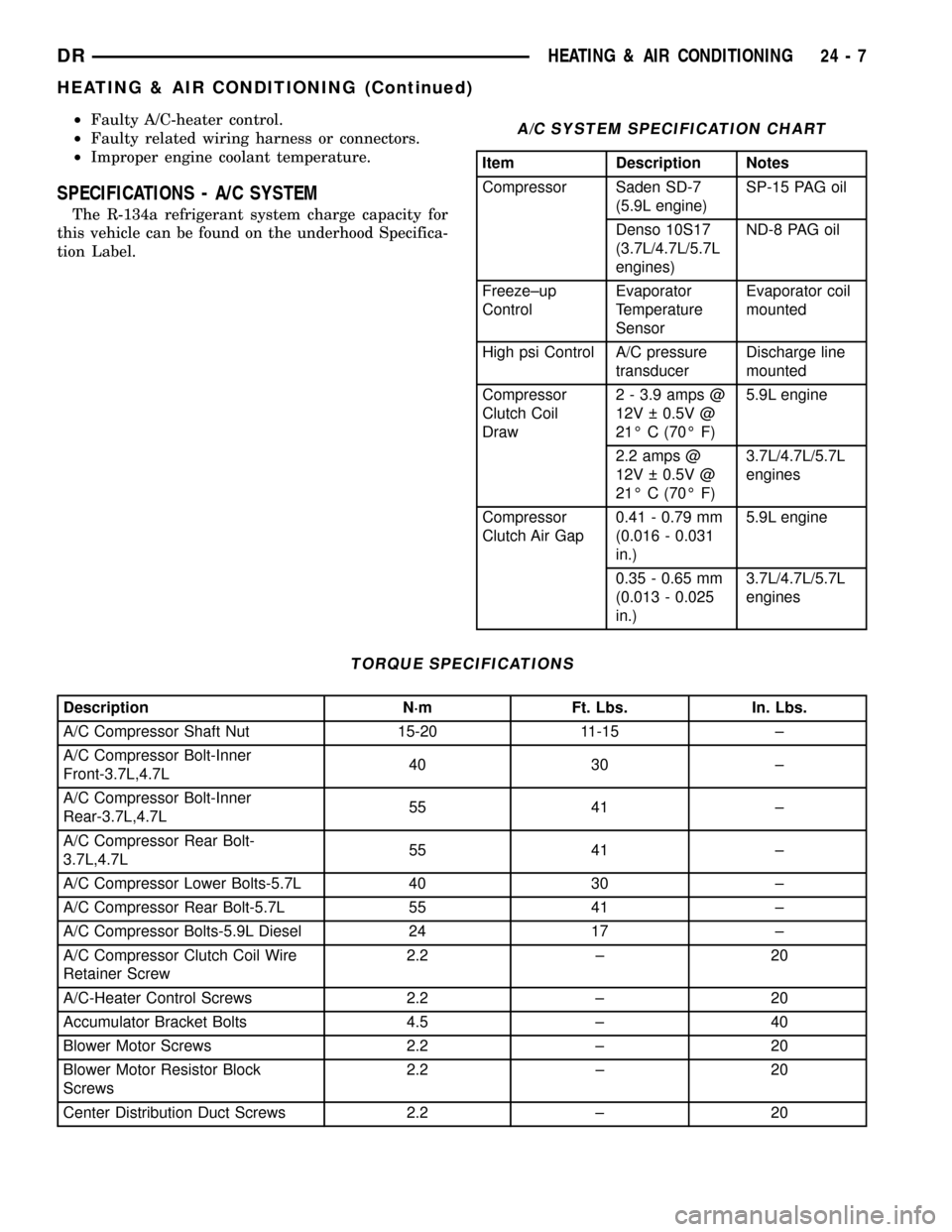Page 2494 of 2627

²Faulty A/C-heater control.
²Faulty related wiring harness or connectors.
²Improper engine coolant temperature.
SPECIFICATIONS - A/C SYSTEM
The R-134a refrigerant system charge capacity for
this vehicle can be found on the underhood Specifica-
tion Label.
A/C SYSTEM SPECIFICATION CHART
Item Description Notes
Compressor Saden SD-7
(5.9L engine)SP-15 PAG oil
Denso 10S17
(3.7L/4.7L/5.7L
engines)ND-8 PAG oil
Freeze±up
ControlEvaporator
Temperature
SensorEvaporator coil
mounted
High psi Control A/C pressure
transducerDischarge line
mounted
Compressor
Clutch Coil
Draw2 - 3.9 amps @
12V 0.5V @
21É C (70É F)5.9L engine
2.2 amps @
12V 0.5V @
21É C (70É F)3.7L/4.7L/5.7L
engines
Compressor
Clutch Air Gap0.41 - 0.79 mm
(0.016 - 0.031
in.)5.9L engine
0.35 - 0.65 mm
(0.013 - 0.025
in.)3.7L/4.7L/5.7L
engines
TORQUE SPECIFICATIONS
Description N´m Ft. Lbs. In. Lbs.
A/C Compressor Shaft Nut 15-20 11-15 ±
A/C Compressor Bolt-Inner
Front-3.7L,4.7L40 30 ±
A/C Compressor Bolt-Inner
Rear-3.7L,4.7L55 41 ±
A/C Compressor Rear Bolt-
3.7L,4.7L55 41 ±
A/C Compressor Lower Bolts-5.7L 40 30 ±
A/C Compressor Rear Bolt-5.7L 55 41 ±
A/C Compressor Bolts-5.9L Diesel 24 17 ±
A/C Compressor Clutch Coil Wire
Retainer Screw2.2 ± 20
A/C-Heater Control Screws 2.2 ± 20
Accumulator Bracket Bolts 4.5 ± 40
Blower Motor Screws 2.2 ± 20
Blower Motor Resistor Block
Screws2.2 ± 20
Center Distribution Duct Screws 2.2 ± 20
DRHEATING & AIR CONDITIONING 24 - 7
HEATING & AIR CONDITIONING (Continued)
Page 2522 of 2627

DISASSEMBLY
(1) Remove the HVAC housing from the vehicle
and place it on the workbench (Refer to 24 - HEAT-
ING & AIR CONDITIONING/DISTRIBUTION/HVAC
HOUSING - REMOVAL).
(2) Disconnect the electrical connectors from the
blower motor, blower motor resistor block, evaporator
temperature sensor and each actuator (Fig. 10).
(3) Remove the HVAC wiring harness from the
HVAC housing.
(4) If necessary, remove the blower motor from
the HVAC housing (Refer to 24 - HEATING & AIR
CONDITIONING/DISTRIBUTION/BLOWER
MOTOR - REMOVAL).
(5) If necessary, remove the blower motor resistor
block from the HVAC housing (Refer to 24 - HEAT-
ING & AIR CONDITIONING/CONTROLS/BLOWER
MOTOR RESISTOR BLOCK - REMOVAL).
(6) Carefully remove the foam seals from the
heater core and evaporator coil tube mounting flange
of the HVAC housing. If the either seal is deformed
or damaged, it must be replaced.
(7) Remove the screws that secure the heater core
in the HVAC housing and carefully remove the
heater core from the housing (Refer to 24 - HEAT-
ING & AIR CONDITIONING/PLUMBING/HEATER
CORE - REMOVAL).(8) Use a screwdriver to pry off the four snap clips
that help secure the upper and lower HVAC housing
halves together.
(9) Remove the screws that secure the upper and
lower HVAC housing halves to each other and those
that secure the recirculation housing to the upper
HVAC housing.
(10) Carefully separate the recirculation housing
and the upper HVAC housing from the lower hous-
ing.
ASSEMBLY
(1) Position the upper HVAC housing to the lower
housing. During assembly, be certain of the following:
(a) That each of the door pivot shaft ends are
properly engaged in there pivot holes.
(b) That the evaporator drain opening is clean
and the drain foam seal is properly installed.
(2) Install the screws and snap clips that secure
the upper and lower HVAC housing halves to each
other and those that secure the recirculation housing
to the upper HVAC housing. Tighten the screws to
2.2 N´m (20 in. lbs.).
(3) Install the foam seals on the heater core and
evaporator coil tubes.
(4) If removed, install the blower motor resistor
block (Refer to 24 - HEATING & AIR CONDITION-
Fig. 10 HVAC Housing - Disassembled
1 - RECIRCULATION HOUSING
2 - RECIRC DOOR ACTUATOR
3 - DRIVER SIDE BLEND DOOR ACTUATOR
4 - FLOOR DISTRIBUTION DUCT
5 - DEFROST DOOR ACTUATOR
6 - PANEL DOOR ACTUATOR
7 - UPPER HVAC HOUSING
8 - PASSENGER SIDE BLEND DOOR ACTUATOR9 - HEATER CORE
10 - LOWER HVAC HOUSING
11 - HVAC WIRE HARNESS
12 - DRAIN FOAM SEAL
13 - BLOWER MOTOR
14 - EVAPORATOR FOAM SEAL
15 - EVAPORATOR
16 - HEATER CORE FOAM SEAL
DRDISTRIBUTION 24 - 35
HVAC HOUSING (Continued)
Page 2551 of 2627

HEATER INLET HOSE
REMOVAL
The heater inlet hose is constructed from rubber
hoses and plastic hose connectors. The ends are
secured to the heater core, engine and engine coolant
reservoir (depending on engine application) by spring
tension clamps.
WARNING: REVIEW THE WARNINGS AND CAU-
TIONS IN THE FRONT OF THIS SECTION BEFORE
PERFORMING THE FOLLOWING OPERATION (Refer
to 24 - HEATING & AIR CONDITIONING/PLUMBING -
WARNING) and (Refer to 24 - HEATING & AIR CON-
DITIONING/PLUMBING - CAUTION).
(1) Drain the engine cooling system (Refer to 7 -
COOLING - STANDARD PROCEDURE - COOLING
SYSTEM DRAIN).
(2) Remove the heater hose retaining brackets as
required (depending on engine application).
(3) Using spring tension clamp pliers, compress
and slide the clamps off of each end of the hose being
removed (Fig. 24).
CAUTION: DO NOT apply excessive pressure on
heater tubes or connections when removing heater
hoses. Excessive pressure may damage or deform
the tubes/heater core, causing an engine coolant
leak.
(4) Disconnect each hose end by carefully twisting
the hose back and forth on the tube, while gently
pulling it away from the end of the tube.
(5) If necessary, carefully cut the hose end and
peel the hose off of the tube.
NOTE: Replacement of the heater inlet hose will be
required if the hose ends are cut for removal.
(6) Remove the heater inlet hose from the engine
compartment.
(7) Separate the heater hoses from each other as
required (depending on engine application).
INSTALLATION
(1) If separated, reconnect the heater hoses to each
other as required (depending on engine application).
(2) Position the heater inlet hose into the engine
compartment.
(3) Using spring tension clamp pliers, compress
and slide each clamp away from the end of the hose
being installed.
(4) Install each hose by carefully twisting the hose
back and forth while gently pushing it onto the tube
end.(5) Using spring tension clamp pliers, compress
and slide the clamps onto each end of the hose being
installed.
(6) Install the heater hose retaining brackets as
required (depending on engine application).
(7) Refill the engine cooling system (Refer to 7 -
COOLING - STANDARD PROCEDURE - COOLING
SYSTEM REFILL).
HEATER RETURN HOSE
REMOVAL
The heater return hose is constructed from rubber
hoses and plastic hose connectors. The ends are
secured to the heater core, engine and engine coolant
reservoir (depending on engine application) by spring
tension clamps.
WARNING: REVIEW THE WARNINGS AND CAU-
TIONS IN THE FRONT OF THIS SECTION BEFORE
PERFORMING THE FOLLOWING OPERATION (Refer
to 24 - HEATING & AIR CONDITIONING/PLUMBING -
WARNING) and (Refer to 24 - HEATING & AIR CON-
DITIONING/PLUMBING - CAUTION).
Fig. 24 Heater Hoses - Typical
1 - HEATER CORE TUBES
2 - HEATER INLET HOSE
3 - RETAINING BRACKET
4 - HOSE CONNECTOR
5 - SPRING CLAMP
6 - HEATER RETURN HOSE
24 - 64 PLUMBINGDR